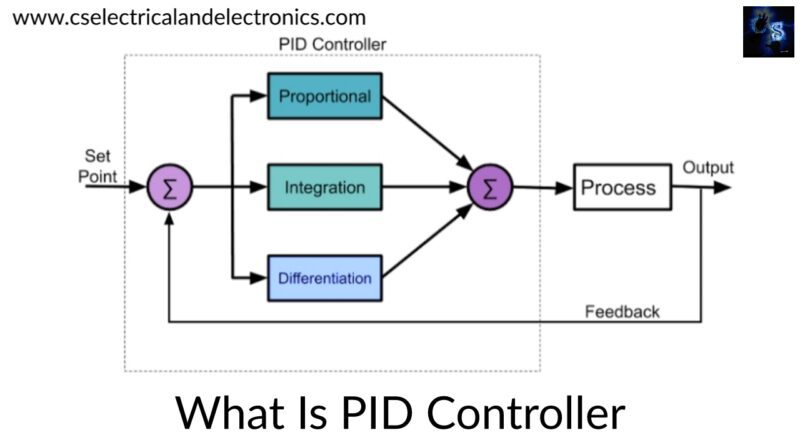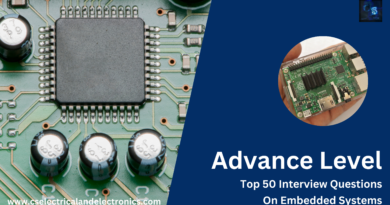What Is PID Controller, Working, Advantages, Disadvantages, Applications
Hello guys, welcome back to my blog. In this article, I will discuss what is PID controller, working of PID controller, advantages, disadvantages, why this is used and it’s applications, etc.
If you have any doubts related to electrical, electronics, and computer science, then ask question. You can also catch me @ Instagram – Chetan Shidling.
Also, read:
- What Is SCADA, Why SCADA Is Needed, Advantages, Disadvantages.
- Top 10 Transformer Manufacturers In India, Transformer Companies.
- Top 10 Electrical Vehicle Manufacturers In India, Electric Vehicle Company.
What Is PID Controller
Proportional + Integral + Derivative Controller or PID Controller. The PID Controller produces an output signal with a feedback loop control consisting of three terms:
- Proportional to the error signal
- Proportional to integral of error signal error
- Proportional to the derivative of the error signal
It is used to regulate pressure, speed, temperature, etc. it is an instrument that is used in industrial control applications. This controller has a feedback loop which is the most accurate and stable controller. It is a well-established way of driving a system towards its output. It operates automatically to give an accurate and responsive correction to a control function.
The PID Controller can be realized by op-amp amplifier with integral and derivative action followed by sign changer. It influences the controller output to optimal and accurate control. P is proportional to the current value. If the error is large and positive, then the control output should also large and positive. I actuate the error and integrates them overtime to produce the Integral term.
When the error is removed, then the Integral term will stop raising. This will result in the diminishing of the proportional term as the error decreases. D sometimes called Anticipatory control, as it is effectively seeking to reduce the effect of the error.
In some controllers, air pressure was used for generating the controller output. These controllers are simple low-maintenance devices that can have the ability to operate well in harsh industrial environments. These controllers are well known and did not present explosion risks in hazardous locations.
Working Of PID Controller
PID Controller consists of only two control states i.e., fully ON or fully OFF. These two control states are more than enough for the control objective. PID Controller can maintain the output such that there exists zero error between setpoint and reference. PID Controller uses three basic control behaviors.
P-Controller:-
It gives an output that is proportional to the current error. This controller compares the set point with the actual value or the reference and the resulting error is multiplied with a proportional constant to get the output. The output of the controller always depends on the error value that is if the error value is zero, then this controller output is zero. P Controller requires biasing to provide stable operation but it always maintains the steady-state error.
I-Controller:-
I Controller provides necessary action to eliminate the steady-state error. It integrates the error signal over a certain period of time until the error signal reaches zero. This controller decreases the output when a negative error takes place. The speed of the response is inversely proportional to the integral gain. As the gain of the I- Controller decreases, the steady-state error also decreases.
D-Controller:-
D Controller gets reacted normally once the setpoint is changed. It anticipates the future behavior of the error. So, the D controller is called Anticipatory control. The output of the D controller depends on the rate of change of error with respect to the time which is multiplied by the derivative constant. It improves the stability of the system by compensation. By increasing the derivative, gain increases the speed of the response.
Applications Of PID Controller
01. Temperature control of Furnace: Furnaces are used for heating at high temperatures. It has a high quantity of inertia. This results in a moderately stable signal for fault detection.
02. Neutralization of pH control: PH is the widely viewed thing in industry to control. Its behavior changes from one operating range to another. The dynamics of PH tend to be slow as the amount of acid.
03. PID Controllers are mostly used in converters.
Advantages Of PID Controller
- The P Controller stabilizes the gain but produces a constant steady-state error.
- The I Controller reduces or eliminates the steady-state error.
- The D Controller reduces the rate of change of error.
Disadvantages Of PID Controller
The only disadvantage is the tuning methodology.
I hope this article may help you all a lot. Thank you for reading.
Also, read:
- 10 Tips To Maintain Battery For Long Life, Battery Maintainance
- 10 Tips To Save Electricity Bills, Save Money By Saving Electricity
- 100 (AI) Artificial Intelligence Applications In The Automotive Industry
- 100 + Electrical Engineering Projects For Students, Engineers
- 1000+ Control System Quiz, Top MCQ On Control System
- 1000+ Electrical Machines Quiz, Top MCQs On Electrical Machines
- 1000+ Electronics Projects For Engineers, Diploma, MTech Students
- 1000+ MATLAB Simulink Projects For MTech, Engineering Students
Author Profile
- Content Writer








